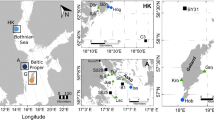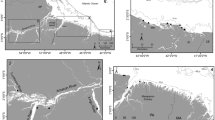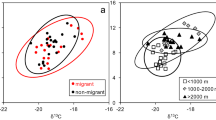Abstract
Stable isotopes have proven effective in the ecological study of terrestrial, freshwater, marine and estuarine systems. However, their utility in the study of large migratory fishes in the dynamic ocean may be more difficult to ascertain. Migration across large areas of ocean in short periods of time may result in a large amount of variability in the nitrogen ratios of large pelagic fishes. High variability was found in nitrogen ratios (δ15N) used to quantify trophic positions of large pelagic fish species and their prey in the southern Gulf of California. Mean δ15N values for eleven large pelagic predators ranged from 14.8 ‰ for blue marlin to 18.7 ‰ for amberjack. Predators typically present in the Gulf during winter months had a higher mean value (18.5 ± 0.7 ‰) than summer predators (15.8 ± 1.5 ‰). Common prey items, including cephalopods, fish and crustaceans, had mean δ15N values ranging from 12.2 to 19.1 ‰ (epipelagic fishes = 17.5 ± 0.7 ‰, cephalopods = 15.6 ± 0.9 ‰, inshore fishes = 14.2 ± 1.6 ‰, crustaceans = 12.2 ± 0.4 ‰), in many cases exceeding their predators by more than one full trophic level. We analyzed potential sources of this variability by examining diets, oceanographic conditions and fish migration. Diet shifts with size do not account for the variability, but the likely source appears to be slow turnover rate of body tissues of migratory pelagic fish as they traverse both highly productive and oligotrophic water masses in the eastern Pacific Ocean. From this study, we advise caution when interpreting results of stable isotope ratios in migratory pelagic fishes, and suggest designing studies that account for sources of variability.





Similar content being viewed by others
References
Aberle N, Malzahn AM (2007) Interspecific and nutrient-dependent variations in stable isotope fractionation: experimental studies simulating pelagic multitrophic systems. Oecologia 154:291–303
Abitia-Cárdenas LA, Galván-Magaña F, Gutierrez-Sanchez FJ, Rodrίguez-Romero J, Aguilar-Palomino B, Moehl-Hitz A (1999) Diet of blue marlin Makaira mazara off the coast of Cabo San Lucas, Baja California Sur, Mexico. Fish Res 44:95–100
Altabet MA (2001) Nitrogen isotopic evidence for micronutrient control of fractional \({\text{NO}}_{3}^{ - }\) utilization in the equatorial Pacific. Limnol Oceanogr 46:368–380
Altabet MA, Pilskaln C, Thunell R, Pride C, Sigman D, Chavez F, Francois R (1999) The nitrogen isotope biogeochemistry of sinking particles from the margin of the Eastern North Pacific. Deep Sea Res I 46:655–679
Aurioles-Gamboa D, Rodríguez-Pérez MY, Sánchez-Velasco L, Lavín MF (2013) Habitat, trophic level, and residence of marine mammals in the Gulf of California assessed by stable isotope analysis. Mar Ecol Prog Ser 488:275–290
Badandangon A, Koblinksy CJ, Baumgartner T (1985) Spring and summer in the Gulf of California: observations of surface thermal patterns. Oceanol Acta 8:13–22
Block BA, Jonsen ID, Jorgensen SJ, Winship AJ, Shaffer SA, Bograd SJ, Hazen EL, Foley DG, Breed GA, Harrison AL, Ganong JE, Swithenbank A, Castleton M, Dewar H, Mate BR, Shillinger GL, Schaefer KM, Benson SR, Weise MJ, Henry RW, Costa DP (2011) Tracking apex predator movements in a dynamic ocean. Nature 475:86–90
Borrell A, Cardona L, Kumarran RP, Aguilar A (2011) Trophic ecology of elasmobranchs caught off Gujarat, India, as inferred from stable isotopes. ICES J Mar Sci 68:547–554
Bray NA, Robles JM (1991) Physical oceanography of the Gulf of California. In: Simoneit B, Dauphin P (eds) The gulf and peninsular province of the Californias. American Association of Petroleum Geologists, Tulsa, pp 511–553
Carlisle AB, Kim SL, Semmens BX, Madigan DJ, Jorgensen SJ, Perle CR, Anderson SD, Chapple TK, Kanive PE, Block BA (2012) Using stable isotope analysis to understand the migration and trophic ecology of northeastern Pacific white sharks (Carcharodon carcharias). PLoSOne 7:1–15
Carpenter EJ, Harvery HR, Fry B, Capone DG (1997) Biogeochemical tracers of the marine cyanobacterium Trichodesmium. Deep Sea Res 44:27–38
Cervántes-Duarte R, VerdugoDíaz G, ValdezHolguίn JE (2005) Modelo estacional de producción primaria estimada mediante fluorescencia natural en una región costera del Golfo de California, México. Hidrobiológica 15:79–87
Cherel Y, Hobson KA, Guinet C, Vanpe C (2007) Stable isotopes document seasonal changes in trophic niches and winter foraging individual specialization in diving predators from the Southern Ocean. J Anim Ecol 76:826–836
Costalago D, Navarro J, Álvarez-Calleja I, Palomera I (2012) Ontogenetic and seasonal changes in the feeding habits and trophic levels of two small pelagic fish species. Mar Ecol Prog Ser 460:169–181
Davenport SR, Bax NJ (2002) A trophic study of a marine ecosystem off southeastern Australia using stable isotopes of carbon and nitrogen. Can J Fish Aquat Sci 59:514–530
DeNiro MJ, Epstein S (1981) Influence of diet on the distribution of nitrogen isotopes in animals. Geochim Cosmochim Acta 45:341–351
Domeier ML (2006) An analysis of pacific striped marlin (Tetrapturus audax) horizontal movement patterns using pop-up satellite archival tags. Bull Mar Sci 79:811–825
Estrada JA, Rice AN, Lutcavage ME, Skomal GB (2003) Predicting trophic position in sharks of the north-west Atlantic Ocean using stable isotope analysis. J Mar Biol Assoc UK 83:1347–1350
France RL (1995) Differentiation between littoral and pelagic food webs in lakes using carbon isotopes. Limnol Oceanogr 40:1310–1313
Fry B (2006) Stable isotope ecology. Springer, New York, 308 pp
Fry B, Arnold CK (1982) Rapid 13C/12C turnover during growth of brown shrimp (Penaeus aztecus). Oecologia 54:200–204
González-Armas R, Palomares-Garcia R, De Silva-Davila R (2002) Copepod and macrozooplankton distribution associated to El Bajo Espiritu Santo Seamount. In: Hendrickx ME (ed) Contributions to the study of east Pacific crustaceans. UNAM, Mexico, pp 1–11
Graham B, Olson R, Fry B, Popp B, Allain V, Galván-Magaña F (2006) The new PFRP tag: using stable isotope techniques to better understand the trophic ecology and migration patterns of tropical tunas. PFRP Newsl 11:1–3
Graham BS, Grubbs D, Holland K, Popp BN (2007) A rapid ontogenetic shift in the diet of juvenile yellowfin tuna from Hawaii. Mar Biol 150:647–658
Graham BS, Koch PL, Newsome SD, McMahon KW, Auriole D (2010) Using isoscapes to trace the movements and foraging behavior of top predators in oceanic ecosystems. In: West JB (ed) Isoscapes. Springer, Dordrecht, pp 299–318
Hidalgo-González RM, Álvarez-Borrego S (2001) Chlorophyll profiles and the water column structure in the Gulf of California. Oceanol Acta 24:19–28
Hussey NE, MacNeil MA, Fisk AT (2010) The requirement for accurate diet-tissue discrimination factors for interpreting stable isotopes in sharks. Hydrobiologia 654:1–5
Hussey NE, MacNeil MA, Olin JA, McMeans BC, Kinney MJ, Chapman DD, Fisk AT (2012) Stable isotopes and elasmobranchs: tissue types, methods, applications and assumptions. J Fish Biol 80:1449–1484
Hyrenbach KD, Forney KA, Dayton PK (2000) Marine protected areas and ocean basin management. Aquat Conserv Mar Freshw Ecosyst 10:437–458
Hyslop EJ (1980) Stomach contents analysis—a review of methods and their application. J Fish Biol 17:411–429
Jorgensen SJ (2006) Movement rates of marine fishes and the implication of dispersal for population persistence in marine reserves. Dissertation, University of California
Kiljunen M, Grey J, Sinisalo T, Harrod C, Immonen H, Jones RI (2006) A revised model for lipid-normalizing δ13C values from aquatic organisms, with implications for isotope mixing models. J Appl Ecol 43:1213–1222
Kim SL, Martínez del Rio C, Casper D, Koch PL (2012) Isotopic incorporation rates for shark tissues from a long-term captive feeding study. J Exp Biol 215:2495–2500
Klimley AP, Butler SB (1988) Immigration and emigration of a pelagic fish assemblage to seamounts in the Gulf of California related to water mass movements using satellite imagery. Mar Ecol Prog Ser 49:11–20
Klimley AP, LeBoeuf BJ, Cantara KM, Richert JE, Davis SF, Van Sommeran S (2001) Radio-acoustic positioning as a tool for studying site-specific behavior of the white shark and other large marine species. Mar Biol 138:429–446
Klimley AP, Jorgensen SJ, Muhlia-Melo A, Beavers SC (2003) The occurrence of yellowfin tuna (Thunnus albacares) at Espiritu Santo Seamount in the Gulf of California. Fish Bull 101:684–692
Klimley AP, Richert JE, Jorgensen SJ (2005) The home of blue water fishes. Am Sci 93:42–49
Lluch-Cota SE (2000) Coastal upwelling in the eastern Gulf of California. Oceanol Acta 23:731–740
Logan JM, Lutcavage ME (2010) Stable isotope dynamics in elasmobranch fishes. Hydrobiologia 644:231–244
Lorrain A, Graham B, Menard F, Popp B, Bouillon S, van Breugel P, Cherel Y (2009) Mar Ecol Prog Ser 391:293–306
Madigan DJ, Litvin SY, Popp BN, Carlisle AB, Farwell CJ, Block BA (2012) Tissue turnover rates and isotopic trophic discrimination factors in the endothermic teleost, Pacific bluefin tuna (Thunnus orientalis). PLoS One 7(11):e49220. doi:10.1371/journal.pone.0049220
Malpica-Cruz L, Herzka SZ, Sosa-Nishizaki O, Escobedo-Olvera MA (2013) Tissue-specific stable isotope ratios of shortfin mako (Isurus oxyrinchus) and white (Carcharodon carcharias) sharks as indicators of size-based differences in foraging habitat and trophic level. Fish Oceanogr 22:429–445
Maruyama A, Yamada Y, Rusuwa B, Yuma M (2001) Change in stable nitrogen isotope ratio in the muscle tissue of a migratory goby, Rhinogobius sp., in a natural setting. Can J Fish Aquat Sci 58:2125–2128
McClelland JW, Holl CM, Montoya JP (2003) Relating low δ15N values of zooplankton to N2-fixation in the tropical North Atlantic: insights provided by stable isotope ratios of amino acids. Deep Sea Res I 50:849–861
Minagawa M, Wada E (1984) Stepwise enrichment of 15N along food chains: further evidence and the relation between δ15N and animal age. Geochim Comochim Acta 48:1135–1140
Montoya JP, Carpenter EJ, Capone DG (2002) Nitrogen fixation and nitrogen isotope abundance in zooplankton of the oligotrophic North Atlantic. Limnol Oceanogr 47:1617–1628
Moteki M, Arai M, Tsuchiya K, Okamoto H (2001) Composition of piscine prey in the diet of large pelagic fish in the eastern tropical Pacific Ocean. Fish Sci 67:1063–1074
Muhlia-Melo A (1996) Interactions of tunas and big pelagic fishes among sport and commercial fisheries in Mexican waters of the Pacific Ocean. FAO Fish Tech Pap 365:241–250
Muhlia-Melo A, Klimley P, González-Armas R, Jorgensen S, Trasviña-Castro A, Rodrίguez-Romero J, Amador-Buenrostro A (2003) Pelagic fish assemblages at the Espiritu Santo seamount in the Gulf of California during El Nino 1997–1998 and non-El Niño conditions. Geofis Int 42:473–481
Myers RA, Worm B (2003) Rapid worldwide depletion of predatory fish communities. Nature 423:280–283
O’Reilly CM, Verburg P, Hecky RE, Plisnier PD, Cohen AS (2004) Food web dynamics in stable isotope ecology: time integration of different trophic levels. In: Seuront L, Strutton PG (eds) Handbook of scaling methods in aquatic ecology: measurement, analysis simulation. CRC Press, Boca Raton, pp 125–133
Olson RJ, Galván-Magaña F (2002) Food habits and consumption rates of common dolphinfish (Coryphaena hippurus) in the eastern Pacific Ocean. Fish Bull 100:279–298
Pauly D, Christensen V, Dalsgaard J, Froese R, Torres F (1998) Fishing down marine food webs. Science 279:860–863
Peterson BJ (1999) Stable isotopes as tracers of organic matter input and transfer in benthic food webs: a review. Acta Oecol 20:479–487
Peterson BJ, Fry B (1987) Stable isotopes in ecosystem studies. Annu Rev Ecol Sys 18:293–320
Post DM (2002) Using stable isotopes to estimate trophic position: models methods, and assumptions. Ecology 83:703–718
Post DM, Layman CA, Arrington DA, Takimoto G, Quattrochi J, Montana CG (2007) Getting to the fat of the matter: models, methods and assumptions for dealing with lipids in stable isotope analyses. Oecologia 152:179–189
Prince ED, Holts DB, Snodgrass D, Orbesen ES, Luo J, Domeier ML, Serafy JE (2006) Transboundary movement of sailfish, Istiophorus platypterus, off the pacific coast of central America. Bull Mar Sci 79:827–838
Richert JE (2007) Trophic ecology of large pelagic fishes in the southern Gulf of California. Dissertation, University of California
Sala E, Aburto-Oropeza O, Reza M, Paredes G, Lόpez-Lemus LG (2004) Fishing down coastal food webs in the Gulf of California. Fish 29:19–25
Sara G, Sara R (2007) Feeding habits and trophic levels of bluefin tuna Thunnus thynnus of different size classes in the Mediterranean Sea. J Ichthyl 2007:122–127
Schaefer KM, Fuller DW, Block BA (2007) Movements, behavior, and habitat utilization of yellowfin tuna (Thunnus albacares) in the northeastern Pacific Ocean, ascertained through archival tag data. Mar Biol 152:503–525
Schaefer KM, Fuller DW, Block BA (2011) Movements, behavior, and habitat utilization of yellowfin tuna (Thunnus albacares) in the Pacific Ocean off Baja California, Mexico, determined from archival tag data analyses, including unscented Kalman filtering. Fish Res 112:22–37
Seki MP, Lumpkin R, Flament P (2002) Hawaii cyclonic eddies and blue marlin catches: the case study of the 1995 Hawaiian international billfish tournament. J Ocean 58:739–745
Sigman DM, Casciotti KL (2001) Nitrogen isotopes in the ocean. In: Steele JH, Thorpe SA, Turekian KK (eds) Encyclopedia of ocean sciences: 1884–1894. Academic Press, New York
Sigman DM, Altabet MA, McCorkel DC, Francois R, Fischer G (2000) The δ15N of nitrate in the Southern Ocean: nitrogen cycling and circulation in the ocean interior. J Geophys Res Ocean C 105:19599–19614
Squire JL (1987) Striped marlin, Tetrapturus audax, migration patterns and rates in the northeast Pacific Ocean as determined by a cooperative tagging program: its relation to resource management. Mar Fish Rev 49:26–43
Squire JL, Suzuki Z (1990) Migration trends of striped marlin (Tetrapturus audax) in the Pacific Ocean. In: Stroud RH (ed) Planning the future of billfishes, part 2. National Coalition for Marine Conservation, Savannah, 321 pp
Sutka RL, Ostrom NE, Ostrom PH, Phanikumar MS (2004) Stable isotope dynamics of dissolved nitrate in a transect from the North Pacific Subtropical Gyre to the Eastern Tropical North Pacific. Geochim Cosmochim Acta 68:517–527
Tamelander T, Kivimä C, Bellerby RGJ, Renaud PE, Kristiansen S (2009) Base-line variations in stable isotope values in an Arctic marine ecosystem: effects of carbon and nitrogen uptake by phytoplankton. Hydrobiologia 630:63–73
Thunnell RC (1998) Seasonal and annual variability in particle fluxes in the Gulf of California: a response to climate forcing. Deep Sea Res I 45:2059–2083
Torres-Orozco E, Trasviña A, Muhlia-Melo A, Ortega-Garcia S (2005) Mesoscale dynamics and yellowfin tuna catches in the Mexican Pacific. Cienc Mar 31:671–683
Torres-Rojas Y, HernandezHerrera A, Ortega-Garcia S, Domeier M (2013) Stable isotope differences between blue marlin and striped marlin in the southern Gulf of California, Mexico. Bull Mar Sci 89:421–436
Torres-Rojas YE, Paez Osuna F, Agustin Hernandez-Herrera A, Galvan-Magaña F, Aguiniga Garcia S, Villalobos Ortiz H, Sampson L (2014) Feeding grounds of juvenile scalloped hammerhead sharks (Sphyrna lewini) in the south-eastern Gulf of California. Hydrobiologia 726:81–94
Trasviña-Castro A, Gutierrez de Velasco G, Valle-Levinson A, González-Armas R, Mulhia A, Cosio MA (2003) Hydrographic observations of the flow in the vicinity of a shallow seamount top in the Gulf of California. Est Coast Shelf Sci 57:149–162
Vander Zanden MJ, Shuter BJ, Lester N, Rasmussen JB (1999) Patterns of food chain length in lakes: a stable isotope study. Am Nat 154:406–416
Wada E (1980) Nitrogen isotope fractionation and its significance in biogeochemical processes occurring in marine environments. In: Goldberg ED, Horibe Y (eds) Isotope Marine chemistry. Uchida Rokakuho, Tokyo, pp 375–398
Wainright SC, Fuller CM, Michener RH, Richards A (1996) Spatial variation of trophic position and growth rate of juvenile striped bass in the Delaware River. Can J Fish Aquat Sci 53:685–692
Acknowledgments
We would like to thank Dr. Galván, Sofia Ortega and their students CICIMAR-IPN in La Paz, Mexico, for help in sample collection. Chris Moyers and “Chuey” from the East Cape Smokehouse were an invaluable part of the sampling efforts, as were Juan Carlos Perez, Juan Fuentes, and the team at Iemanya Oceanica. I want to acknowledge the financial support of an NSF Graduate Research Fellowship as well as the UC Pacific Rim Research Program, UC MEXUS, and the David and Lucille Packard for research funding. Also much thanks to Sora Kim for reading and comments on an early form of this manuscript.
Author information
Authors and Affiliations
Corresponding author
Additional information
Communicated by C. Harrod.
Electronic supplementary material
Below is the link to the electronic supplementary material.
Rights and permissions
About this article
Cite this article
Richert, J.E., Galván-Magaña, F. & Klimley, A.P. Interpreting nitrogen stable isotopes in the study of migratory fishes in marine ecosystems. Mar Biol 162, 1099–1110 (2015). https://doi.org/10.1007/s00227-015-2652-6
Received:
Accepted:
Published:
Issue Date:
DOI: https://doi.org/10.1007/s00227-015-2652-6




